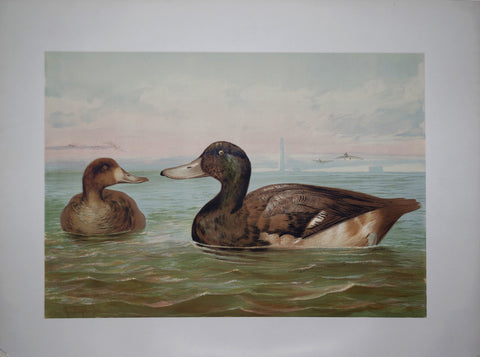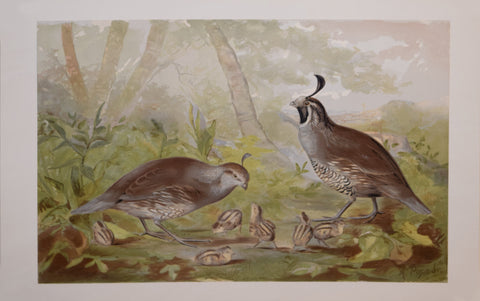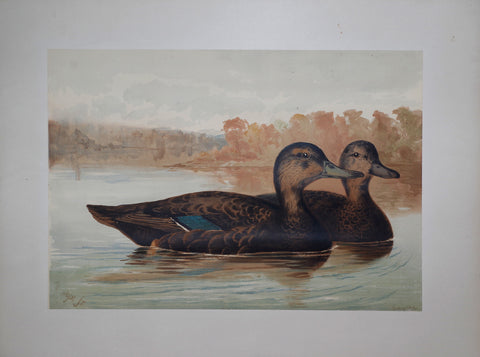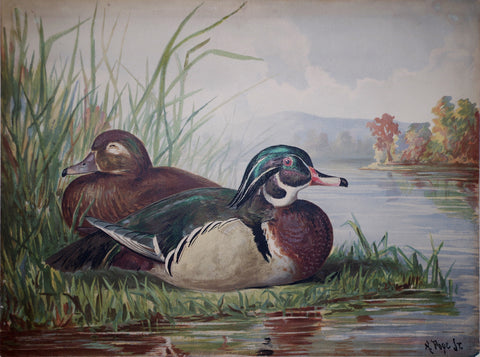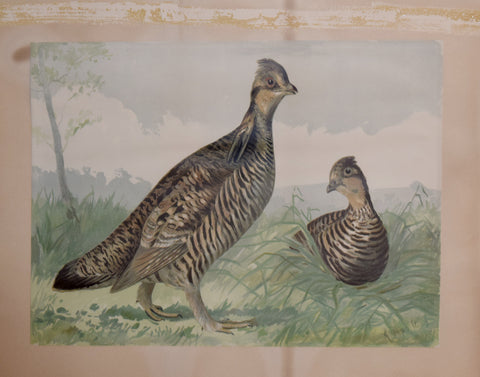Search By Artist
Alexander Pope, Jr. (1849-1924)
From Upland Game Birds and Water Fowl of the United States.
New York: Scribner, Armstrong and Co., 1877-78.
Chromolithographs.
Alexander Pope Jr. was a renowned American sporting artist who specialized in animal and still life paintings. Born in Dorchester, Massachusetts in 1849, he briefly studied sculpture with the prominent artist William Copley and essentially taught himself to paint. Although primarily lauded as a painter, he continued producing sculptures well into the 1880s and later became a member of the famed art association the Copley Society of Boston. In 1878 and 1882, he published two important portfolios of chromolithographs after his watercolours: Upland Game Birds and Water Fowl of the United States, from which this plate comes, and Celebrated Dogs of America respectively. In addition to his more conventional animal paintings, Pope was also known for his still-life compositions of dead animals hanging in the interior of wooden crates, which innovatively combined his avid interest in hunting and fishing with the trompe l'oeil style of painting. His works and those of the influential trompe l'oeil painter William Harnett (1848-1892) helped popularize the genre of still life in late nineteenth-century America. Cf. Benezit, Dictionnaire des Peintres, Sculpteurs, Dessinateurs, et Graveurs vol. 11, p. 140.
The "Upland Game Birds and Water Fowl of the United States," is a rare American series of prints with wonderful landscape backgrounds reminiscent of the Hudson River Portfolio.
As a youth, Alexander Pope carved and sketched animals around his home in Massachusetts. In the 1860s, he worked for his family?s lumber business. Pope studied carving, painting, perspective, and anatomy with William Rimmer, an important romantic-baroque sculptor, painter, and influential teacher of many Boston artists. From 1879 to 1883, Pope created many well-received carvings of game. Czar Alexander III of Russia acquired two of the carvings. In 1893, Pope began painting animal portraits and, later, pursued a career as a portrait painter. Eventually, he was considered one of the best Bostonian trompe l'oeil painters of the nineteenth century. (Dorchester Atheneum).
Alexander Pope Jr. was a renowned American sporting artist who specialized in animal and still life paintings. Born in Dorchester, Massachusetts in 1849, he briefly studied sculpture with the prominent artist William Copley and essentially taught himself to paint. Although primarily lauded as a painter, he continued producing sculptures well into the 1880s and later became a member of the famed art association the Copley Society of Boston. In 1878 and 1882, he published two important portfolios of chromolithographs after his watercolours: Upland Game Birds and Water Fowl of the United States, from which this plate comes, and Celebrated Dogs of America respectively. In addition to his more conventional animal paintings, Pope was also known for his still-life compositions of dead animals hanging in the interior of wooden crates, which innovatively combined his avid interest in hunting and fishing with the trompe l'oeil style of painting. His works and those of the influential trompe l'oeil painter William Harnett (1848-1892) helped popularize the genre of still life in late nineteenth-century America. Cf. Benezit, Dictionnaire des Peintres, Sculpteurs, Dessinateurs, et Graveurs vol. 11, p. 140.
The "Upland Game Birds and Water Fowl of the United States," is a rare American series of prints with wonderful landscape backgrounds reminiscent of the Hudson River Portfolio.
As a youth, Alexander Pope carved and sketched animals around his home in Massachusetts. In the 1860s, he worked for his family?s lumber business. Pope studied carving, painting, perspective, and anatomy with William Rimmer, an important romantic-baroque sculptor, painter, and influential teacher of many Boston artists. From 1879 to 1883, Pope created many well-received carvings of game. Czar Alexander III of Russia acquired two of the carvings. In 1893, Pope began painting animal portraits and, later, pursued a career as a portrait painter. Eventually, he was considered one of the best Bostonian trompe l'oeil painters of the nineteenth century. (Dorchester Atheneum).


